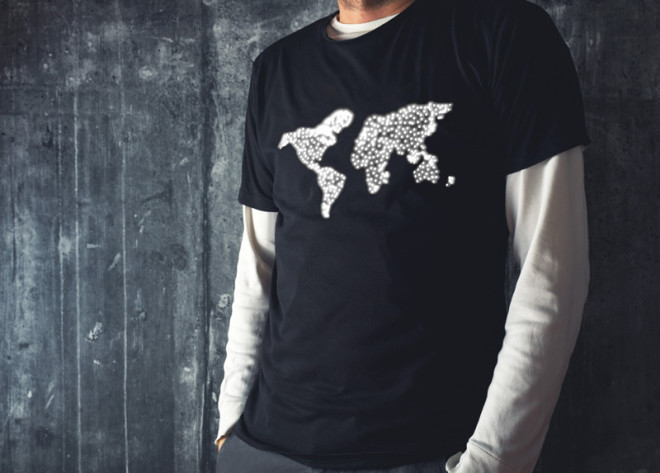Today, electronics are part of our fabric, defining personal tastes and how we operate. There’s a particular irony, as technology continues to advance, however, that we are on the brink of having electronics actually woven into the fabrics we wear.
The idea of polymer light-emitting electrochemical cells (PLECs) being woven into textiles and fabrics might have been far-fetched even a few years ago, but as the world grows accustomed to more and more devices attached to our persons at work, at home, and while we exercise, the idea has become part of the narrative of our technological future.
A Lighter Weave
A research team based in China has been hard at work with that end in mind, trying to address the many challenges associated with embedding.
Shalini Saxena, a writer for Ars Technica, an online magazine covering technological innovations around the world, describes the many challenges being addressed in relation to embedding functional, light-emitting technology into textile garments. “Fabrics themselves are not a suitable surface for current light-emitting materials,” she says; however, she’s optimistic about some of the findings of the research.
But what is the purpose of polymer light-emitting electrochemical cells being embedded in textiles? “PLECs have a structure that is composed of two metal electrodes,” says Saxena, “connected to a thin organic layer that acts as a semiconductor.” In basic terms, they’re an off-shoot of existing LED technology, only with a handful of compelling benefits, including:
- lower operating voltage;
- higher power efficiency;
- the use of fewer metals with particular sensitivities to air exposure; and
- greater durability.
It’s these benefits that have made PLECs the leading candidate for textile use, and that make them a viable option for larger-scale production, according to Saxena.
Realism and Optimism
None of this is to say that PLECs and their use in light-emitting fabrics is without limitation. A significant process remains in the creation of these cells, including:
- dipping a steel wire—the base of the fibre—in nanoparticles, which helps protect the subsequent layer from damage and limit current leakage from the cell;
- depositing an electroluminescent polymer layer onto this dip-coated wire; and
- wrapping a sheet of carbon nanotubes around this bundle.
If it sounds like this can be a complicated process, well, that’s because it is. Granted, creating any light-emitting diode is a highly technical process, but creating a light-emitting fibre capable of being used in clothing is especially so.
The fibre, once created, also remains an imperfect solution: cells are only able to generate light for a few hours, and after that the light dulls progressively.
“The scientists who created these fibers determined the lifetime of the devices,” says Saxena. “They found that the fibers gradually light up over a 21-minute period and gradually dim over a four-hour period.”
Still, there is reason for optimism, despite the technology being in its infancy. Researchers have found that, when pre-charged, the fibres displayed a “rapid turn-on response that is similar to conventional LEDs,” according to Saxena. Even more, the fibres maintained at least 90 per cent of their brightness when bent, demonstrating that they likely have both the durability and flexibility to endure the rigors of being formed to a person’s body, which is a very promising notion.
The Next Frontier
Many of the barriers that remain may be only temporary—another science and technology article, by science writer Bob Yurka, suggests that “much longer lasting cells may soon be made”—, so while wearable luminescence may remain outside our present reach, the distance is closing rapidly. “It could mark a rapid change in clothing,” says Yurka, for one, “from body suits that show mood by color, to human billboards, to clothes that light up in artistic ways.”
These applications, of course, sound nice for casual use, but they beg the question: Is there real value in the continued pursuit of this technology?
NASA seems to think so. In a report on the ongoing research on smart fabrics, including PLEC-woven fabrics, the organization explores how technologies like these will begin to shape our uses of them. “Smart Fabric technologies are rapidly evolving from hobbyist toys and impractical stylistic elements into real, useful components that can change the way we interact with our environment,” the report states.
As an example, integrated fabric and lighting structures would reduce the volume of lighting and electronic materials and enclosures sent on NASA space missions, resources that are typically stowed and launched separately from crews and create additional logistical challenges.
It remains to be seen how this technology will be of greatest benefit to those of us who aren’t astronauts, mind you. But one thing does seem clear: As the technology continues to advance, everyday, practical applications for its use will begin to come to light—pun very much intended.
About The Author

-
Serial Entrepreneur, Technologist and Inventor.
My objective is to develop useful products that have a net positive effect in the lives of those that use them and the environment that we live in.
CEO of Mission LED Lighting Company Ltd.
- 2017.05.24LED factsWhy Are Cars Switching to LEDs if They’re Too Bright?
- 2017.05.09Be green & saveHow to Easily Replace T8 Fluorescent Tubes With LED
- 2017.03.07Build a better future7 Things About Explosion Proof LED Lighting You Should Know
- 2017.02.28Be green & saveWhy We Love LED Grow Lights (And You Should, Too!)





Leave a Reply